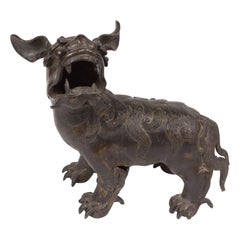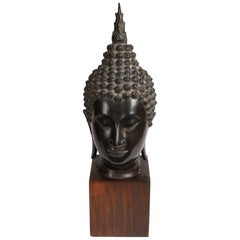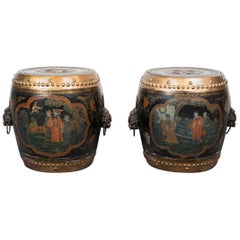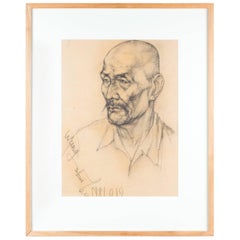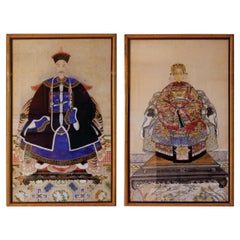Milord Antiques Asian Art and Furniture
8
to
3
8
8
8
2
6
2
3
1
2
1
2
2
2
1
1
7
5
3
2
2
1
Large Gilt Bronze Thai Rattanakosin Buddha
Located in Montreal, QC
Large gilt bronze Thai Rattanakosin buddha eyes inlaid with mother pearl
Category
20th Century Thai Metalwork
Materials
Bronze
19th Century Bronze Chinese Foo Dog
Located in Montreal, QC
19th century bronze Chinese Foo Dog.
Category
Antique 1850s Chinese Archaistic Sculptures and Carvings
Materials
Bronze
Thai Bronze Head of a Buddha
Located in Montreal, QC
Thai bronze head of a Buddha standing on a teak base.
Category
Vintage 1970s Thai More Asian Art, Objects and Furniture
Pair of Painted Wood Asian Style Side Tables
Located in Montreal, QC
Pair of lacquered and painted wood Asian style barrel shape side tables fitted with decorative metal handles.
Category
Vintage 1960s Chinese Chinoiserie Furniture
Materials
Wood
Stunning Portrait of a Man by Shui-Bo Wang
By Shui-Bo Wang
Located in Montreal, QC
Stunning charcoal portrait of a man by Shui-Bo Wang
Born in China on September 11th, 1960, Wang Shui-bo studied visual arts at the Central Academy of Fine Arts in Beijing in the ear...
Category
Vintage 1980s Paintings and Screens
Stylish Japanese "Flambé" Ceramic Vase
Located in Montreal, QC
Studio pottery Japanese “Flambé” glazed ceramic vase.
Category
Vintage 1970s Japanese Ceramics
Materials
Ceramic
Set of 16 Mid-20th Century Prints
Located in Montreal, QC
Whimsical set of 16 Mid-20th Century Japanese woodblock prints. Potentially available in blocks of four.
Category
Mid-20th Century Japanese Prints
Materials
Paper
Pair of Imari Chargers
Located in Montreal, QC
Pair of Japanese Imari chargers showing cranes and Mount Fuji.
Category
Antique 19th Century Japanese Ceramics
Materials
Ceramic
Related Items
Large Pair of Antique Style Bronze Thai Praying Buddhas
Located in Stamford, CT
Large pair of antique style bronze Thai kneeling and praying Buddhas.
Intricate detail, gilt head piece. Probably mid 20th century.
Category
Mid-20th Century Thai Sculptures and Carvings
Materials
Bronze
Large Pair of 19th Century Chinese Framed Ancestor Portraits
Located in Norton, MA
Chinese households honor their ancestors in private family rituals, invoking their spirits for long life, health, and prosperity. Commemorative portraits, which came into vogue in th...
Category
Antique 19th Century Chinese Qing Paintings and Screens
Materials
Glass, Wood, Paint, Paper
Pair of 19th Century Chinese Ancestor Portraits, Large Size, Framed
Located in Doylestown, PA
A nice pair of Chinese ancestor family group portraits, 19th century, on paper, framed in teak frames under glass. Twelve characters total in per...
Category
Antique 19th Century Chinese Qing Paintings
Materials
Paper
LOVELY ANTiQUE CHINESE CHINOISERIE LACQUERED & HAND PAINTED SIDE LAMP WINE TABLE
Located in GB
Royal House Antiques
Royal House Antiques is delighted to offer for sale this exquisite hand made in China Chinoiserie painted and lacquered side table
Please note the delivery fee...
Category
Early 20th Century Chinese Chinoiserie Furniture
Materials
Wood
H 27.17 in Dm 13.98 in
Japanese Glazed Ceramic Vase
Located in Palm Desert, CA
Very unique tall Japanese vase with abstract pattern in a variety of brown tones. The deepest brown glaze is raised, giving the vase a wonderful tac...
Category
Late 20th Century Japanese Organic Modern Vases
Materials
Ceramic
Pair of Asian Chairs Red Lacquered Wood 20th Century
Located in Beuzevillette, FR
Charming pair of Chinese chairs in red lacquered wood. The back of the latter is reminiscent of the bonnet worn by the scholars. The very straight lines of the set give it a very des...
Category
20th Century Chinese Chairs
Materials
Wood
Fine Japanese Satsuma Ceramic Vase by Kinkozan
By Kinkozan
Located in Christchurch, GB
As part of our Japanese works of art collection we are delighted to offer this finely decorated Meiji Period (1868-1912) Satsuma vase stemming from the highly regarded Kinkozan studi...
Category
Antique Late 19th Century Japanese Meiji Ceramics
Materials
Ceramic
Chinese Green Glazed Foo Lions, Near Pair, Late 19th Century, China
Located in Austin, TX
A charming near pair of Chinese green glazed foo lion joss stick holders, late 19th century, China.
The delightful foo lions, also referred to as foo dogs, crafted as joss (incens...
Category
Antique Late 19th Century Chinese Qing Sculptures and Carvings
Materials
Stoneware
Pair of Antique 19th C. Chinese Rice Paper Pith Watercolor Paintings Man & Woman
Located in Dayton, OH
Antique Chinese Export rice paper pith watercolor paintings. Featuring a man and woman in blue robes; framed in deeply beveled floral Aesthetic Period giltwood frames.
Measures: 1...
Category
Antique Late 19th Century Chinese Export Paintings
Materials
Giltwood, Paint, Paper
H 14.5 in W 12.5 in D 2.25 in
Small Asian Chinoiserie Painted Cabinet
Located in Locust Valley, NY
Small Asian chinoiserie painted black cabinet with two doors and brass hardware.
Category
Early 20th Century Asian Chinoiserie Furniture
Materials
Paint
A pair of 19th Century carved Foo temple dogs or Chinese guardian Lions
Located in London, GB
Chinese guardian lions, or imperial guardian lions, are a traditional Chinese architectural ornament. Typically made of stone, they are also known as stone lions or shishi (石獅; shíshī). They are known in colloquial English as lion dogs or foo dogs / fu dogs. The concept, which originated and became popular in Chinese Buddhism, features a pair of highly stylized lions—often one male with a ball and one female with a cub—which were thought to protect the building from harmful spiritual influences and harmful people that might be a threat. Used in imperial Chinese palaces and tombs, the lions subsequently spread to other parts of Asia including Japan (see komainu), Korea, Philippines, Tibet, Thailand, Myanmar, Vietnam, Sri Lanka, Nepal, Cambodia, Laos, and Malaysia.
There has been extensive interaction between Chinese mythology and Confucianism, Taoism, and Buddhism. Elements of pre-Han dynasty mythology such as those in Classic of Mountains and Seas were adapted into these belief systems as they developed (in the case of Taoism), or were assimilated into Chinese culture (in the case of Buddhism). Elements from the teachings and beliefs of these systems became incorporated into Chinese mythology. For example, the Taoist belief of a spiritual Paradise became incorporated into mythology as the place where immortals and deities used to dwell. Sometimes mythological and religious ideas have become widespread across China's many regions and diverse ethnic societies. In other cases, beliefs are more limited to certain social groups, for example, the veneration of white stones by the Qiang. One mythological theme that has a long history and many variations involves a shamanic world view, for example in the cases of Mongolian shamanism among the Mongols, Hmong shamanism among the Miao people, and the shamanic beliefs of the Qing dynasty from 1643 to 1912, derived from the Manchus. Politically, mythology was often used to legitimize the dynasties of China, with the founding house of a dynasty claiming a divine descent.
Mythology and philosophy.
Further information: Chinese philosophy
True mythology is distinguished from philosophical treatises and theories. Elaborations on the Wu Xing are not really part of mythology, although belief in five elements could appear. The Hundred Schools of Thought is a phrase suggesting the diversity of philosophical thought that developed during the Warring States of China. Then, and subsequently, philosophical movements had a complicated relationship with mythology. However, as far as they influence or are influenced by mythology, divides the philosophical camps into two rough halves, a Liberal group and a Conservative group. The liberal group being associated with the idea of individuality and change, for example as seen in the mythology of divination in China, such as the mythology of the dragon horse that delivered the eight bagua diagrams to Fu Xi, and methods of individual empowerment as seen in the Yi Jing (Book of Changes). The Liberal tendency is towards individual freedom, Daoism, and Nature. The relationship of the Conservative philosophies to mythology is seen in the legendary Nine Tripod Cauldrons, mythology about the emperors and central bureaucratic governance, Confucianism, written histories, ceremonial observances, subordination of the individual to the social groups of family and state, and a fixation on stability and enduring institutions. The distinction between the Liberal and Conservative is very general, but important in Chinese thought. Contradictions can be found in the details, however these are often traditional, such as the embrace by Confucius of the philosophical aspects of the Yi Jing, and the back-and-forth about the Mandate of Heaven wherein one dynasty ends and another begins based according to accounts (some of heavily mythological) where the Way of Heaven results in change, but then a new ethical stable dynasty becomes established. Examples of this include the stories of Yi Yin, Tang of Shang and Jie of Xia or the similar fantastic stories around Duke of Zhou and King Zhou of Shang.
Mythology exists in relationship with other aspects of society and culture, such as ritual. Various rituals are explained by mythology. For example, the ritual burning of mortuary banknotes (Hell Money), lighting fireworks, and so on.
A good example of the relationship of Chinese mythology and ritual is the Yubu, also known as the Steps or Paces of Yu. During the course of his activities in controlling the Great Flood, Yu was supposed to have so fatigued himself that he lost all the hair from his legs and developed a serious limp. Daoist practitioners sometimes incorporate a curiously choreographed pedal locomotion into various rituals. Mythology and practice, one explains the other: in these rituals, the sacred time of Yu merges with the sacral practice of the present.
Various ideas about the nature of the earth, the universe, and their relationship to each other have historically existed as either a background or a focus of mythologies. One typical view is of a square earth separated from a round sky by sky pillars (mountains, trees, or undefined). Above the sky is the realm of Heaven, often viewed of as a vast area, with many inhabitants. Often the heavenly inhabitants are thought to be of an "as above so below" nature, their lives and social arrangements being parallel to those on earth, with a hierarchical government run by a supreme emperor, many palaces and lesser dwellings, a vast bureaucracy of many functions, clerks, guards, and servants. Below was a vast under ground land, also known as Diyu, Yellow Springs, Hell, and other terms. As time progressed, the idea of an underground land in which the souls of the departed were punished for their misdeeds during life became explicit, related to developments in Daoism and Buddhism. The underground world also came to be conceived of as inhabited by a vast bureaucracy, with kings, judges, torturers, conductors of souls, minor bureaucrats, recording secretaries, similar to the structure of society in the Middle Kingdom (earthly China).
Chinese temple Dogs...
Category
Antique 1860s Chinese Chinese Export Sculptures and Carvings
Materials
Hardwood
H 11.42 in W 20.48 in D 7.49 in
20C Chinese Soapstone Foo Dog Carving
Located in Dallas, TX
Presenting a lovely 20C Chinese soapstone foo dog carving.
Made in China in the early 20th century circa 1930.
This is a small green and brown ...
Category
Early 20th Century Chinese Chinese Export Sculptures and Carvings
Materials
Soapstone

